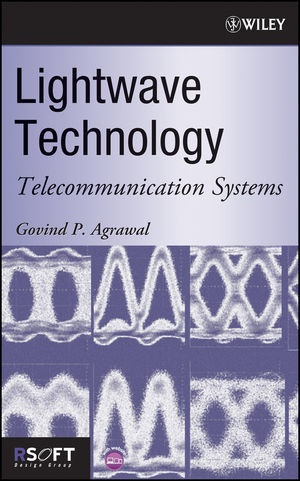Read more
Informationen zum Autor GOVIND P. AGRAWAL, PhD, is a Professor of Optics at The Institute of Optics, University of Rochester, New York, and a Fellow of the Optical Society of America and the IEEE. Internationally recognized as an expert in his field, Dr. Agrawal has authored or coauthored more than 300 research papers, books, and monographs. Klappentext The state of the art of modern lightwave system designRecent advances in lightwave technology have led to an explosion of high-speed global information systems throughout the world. Responding to the growth of this exciting new technology, Lightwave Technology provides a comprehensive and up-to-date account of the underlying theory, development, operation, and management of these systems from the perspective of both physics and engineering.The first independent volume of this two-volume set, Components and Devices, deals with the multitude of silica- and semiconductor-based optical devices. This second volume, Telecommunication Systems, helps readers understand the design of modern lightwave systems, with an emphasis on wavelength-division multiplexing (WDM) systems.* Two introductory chapters cover topics such as modulation formats and multiplexing techniques used to create optical bit streams* Chapters 3 to 5 consider degradation of optical signals through loss, dispersion, and nonlinear impairment during transmission and its corresponding impact on system performance* Chapters 6 to 8 provide readers with strategies for managing degradation induced by amplifier noise, fiber dispersion, and various nonlinear effects* Chapters 9 and 10 discuss the engineering issues involved in the design of WDM systems and optical networksEach chapter includes problems that enable readers to engage and test their new knowledge to solve problems. A CD containing illuminating examples based on RSoft Design Group's award-winning OptSim optical communication system simulation software is included with the book to assist readers in understanding design issues. Finally, extensive, up-to-date references at the end of each chapter enable students and researchers to gather more information about the most recent technology breakthroughs and applications.With its extensive problem sets and straightforward writing style, this is an excellent textbook for upper-level undergraduate and graduate students. Research scientists and engineers working in lightwave technology will use this text as a problem-solving resource and a reference to additional research papers in the field. Zusammenfassung This second independent volume of Govind Agrawal's Lightwave Technology is devoted to the systems design issues with emphasis on WDM systems. It informs practicing engineers and students of both the physics and engineering of lightwave technology and encompasses the latest developments in the field. Inhaltsverzeichnis Preface 1 Introduction 1 1.1 Evolution of Lightwave Systems 1 1.2 Components of a Lightwave System 7 1.2.1 Optical Transmitters 7 1.2.2 Communication Channel 8 1.2.3 Optical Receivers 9 1.3 Electrical Signals 11 1.3.1 Analog and Digital Signals 11 1.3.2 Advantages of Digital Format 12 1.3.3 Analog to Digital Conversion 13 1.4 Channel Multiplexing 16 1.4.1 Time-Division Multiplexing 16 1.4.2 Frequency-Division Multiplexing 18 1.4.3 Code-Division Multiplexing 20 Problems 21 References 22 2 Optical Signal Generation 26 2.1 Modulation Formats 26 2.1.1 ASK Format 28 2.1.2 PSK Format 30 2.1.3 FSK Format 31 2.2 Digital Data Formats 32 2.2.1 Nonreturn-to-Zero Format 33 2.2.2 Return-to-Zero Format 34 2.2.3 Power Spectral Density 34 2.3 Bit-Stream Generation 37 2.3.1 NRZ Transmitters 37 2.3.2 RZ Transmitters 38 2.3.3 Modified RZ Transmitters 40 ...

